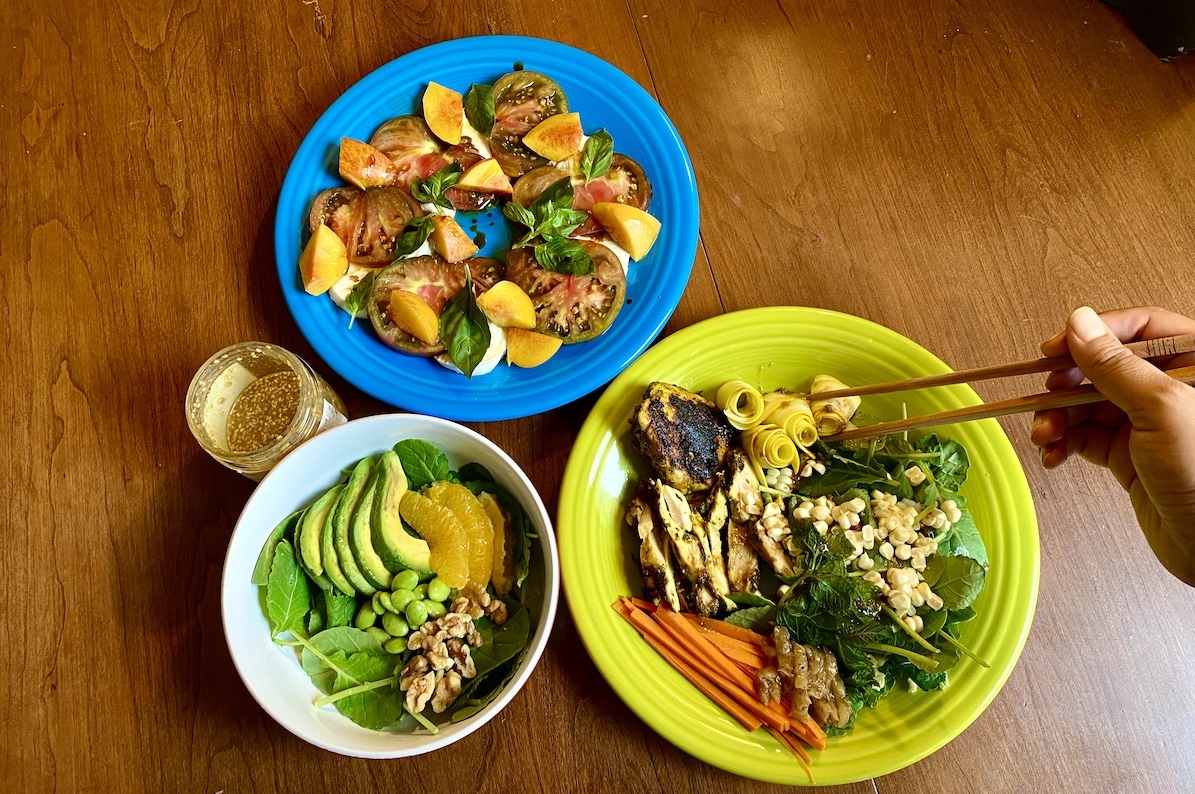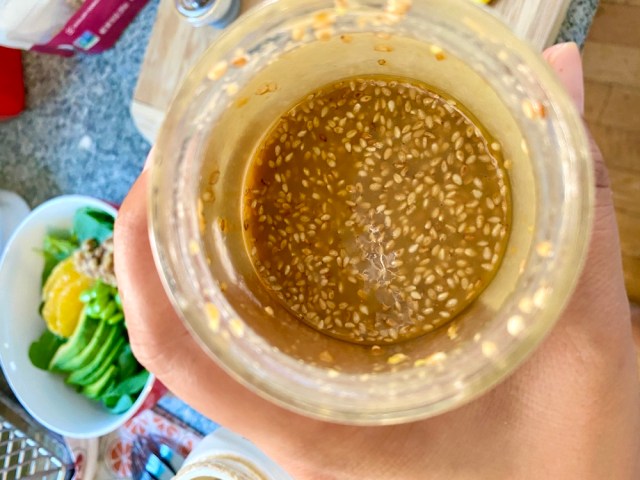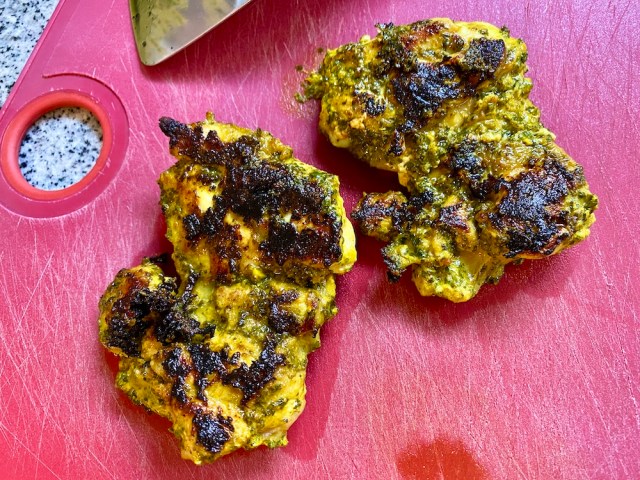
The Dyke Kitchen is a bi-weekly series about how queerness, identity, culture and love are expressed through food and cooking.
I have a lot of feelings about salads. First, it’s a nice thing to eat when it’s 90 degrees in my apartment and it feels like the world, especially on my coast, is on fire. It’s refreshing, re-invigorating, cooling. I have, while stoned and imagining new snack combinations, posed the philosophical question: what is a salad? And the core of my answer revolves around a refreshing experience that involves at least a few fresh, raw ingredients. This captures a full range of salads I love, from potato salad to cold somen noodles to a Jell-O mold with suspended fruit in it — a specialty of one of my Japanese American aunts, who made the most elegant lime Jell-O and lichee molds with a white cream layer. “Refreshing” can mean many different things to different people. I’d call halo-halo a dessert salad.
But I’m here to talk about the kinds of salads that I make, which are not the world’s most complex nor philosophically challenging, but are always built around a kind of balance that I find necessary for a great salad. I know salad is known to many people as a kind of ascetic diet food, but I grew up eating luxurious salads that my mom made. She has shown me wonderful ways to create harmony and surprise in a salad, while also showcasing the best qualities of really good produce. The way my mom does salad feels like the confluence of her being Japanese American, a Calfornian and having family roots in farming and gardening. It’s all about putting foods together that bring out the essences of each other. What I love about salads is that they’re like a live jazz solo, where you can throw together the same ingredients over and over again, and they’ll always be good, but never quite in the same way.

For a Sunday of salads, I ended up making a Caprese salad with nectarine; a classic lunch salad of mine with baby kale, avocado, tangelo slices, edamame and walnuts; and a salad to go with an herb and garlic yogurt marinated chicken (actually the same marinade that we used to make chicken for biriyani) that included raw corn, shaved squash, preserved lime, pickled carrot and mixed greens. I think it goes without saying that whenever you’re eating something raw, the better your produce — ripeness, freshness, variety — the better your salad will be. But these are some other things I consider for the art of salad making.
Salad Tips
Flavor & Texture Balance
Even if it’s just a quick one, because I’m starving and I’m busy and I need to shove some nutrition in my mouth with one hand and type with the other, I’m always looking for a balance of flavors and textures. I want my salad to combine savory, sweet, acidic and fatty. Sometimes I’ll go extra and get sharp or bitter greens in there or give it a spicy edge. You can also pull the flavor harder in one of these directions, but an exciting salad does all of these things for my tongue.
Texturally, I also want a contrast, but within a range. If I’m doing thick slabs of juicy tomato, I also want to cut crunchy chunks of cucumber and hunks of crumbly cheese. If I’m using a silky, fatty dressing, I want a sturdy, cruciferous green. If I have a soft ribbon of prosciutto and thinly sliced fennel root, I want an aggressively crunchy nut. If I’m slicing plums thinly, I want a tender green and shavings of parmesan. You get my point. There should be lots of different textures in every bite, and that often means that I’m thinking about how to cut my vegetables so they either fold together or hold their own.
Get Your Fruit & Herb On
Vegetables are great and I love them dearly, but they’re really amplified by eating them with herbs and fruits. I think it’s just like putting a filter on a photo, they enhance a salad. I try to keep basil, mint and cilantro around at all times, because tossing a handful of them into greens makes it exciting, or carefully placing a basil leaf onto a very well-arranged plate can bring out the nectarine-ness of a nectarine.
Dressing and Self-Dressing
I make a lot of my own dressings. One year in college, I ate in a co-op where my entire job on a lunch cooking crew was to make salad and salad dressing for 3 hours. I could not have been happier. But some of my favorites are really easy. I do one that’s two parts mayo, 1/2 part soy sauce, 1/2 part lemon, then I shake it up in a jar. Why is it so good? You can even add garlic or hot sauce to it. To make my vinaigrettes, I use two parts olive oil, 1/2 part vinegar, a dab of honey and a squeeze of mustard to help bind these sworn enemies — and then toss in whatever I want for flavor: herbs, miso, tahini. preserved limes, smoked chiles, apricot jam, fish sauce, smashed up berries, onions (I’ve never tried these all together, but now I am intrigued…)
Sometimes, when I’m lazy, I pick ingredients that I know will mix up together and form their own sort of dressing. Often, all I need to do is salt the salad, let it sit for a little bit and then toss it. This works really well with citrus, which hits both a sweet and acidic note. You can also do this on the fatty side with eggs, which can run and create a fatty base, and a very ripe avocado or a softer cheese, which will coat everything. If you’re a meat eater, I also do this with chicken and steak, and let the dripping juices dress the salad.
How To Make The Caprese Salad

Ingredients
Fresh mozzarella, I like when the cheese is really fresh and jiggly
Heirloom tomato, I like to get the darker red ones with a spicer flavor and sometimes I’ll mix a yellow one in too
Ripe nectarine
Basil leaves
Olive oil
Balsamic vinegar
Salt & pepper
Directions
Slice the mozzarella and tomato. I like to make them thick enough to get a satisfying bite through them, and still thin enough to really soak up the juices. I also use a serrated knife on tomatoes to get through the skin, and I like the way it cuts through fresh mozzarella too.
Lay the cheese first and then the tomato out on a plate, and salt them. I used a grey salt, and I think Maldon salt is great here too, but any salt will do the trick.
Cut up the nectarine. Because the cheese and tomato are flat, I like to cut angular pieces of the nectarine off of the pit and put them on top, so there are different shapes coming into each bite. I’ve also used plum in this too, which is really tasty.
I place basil leaves on top and then drizzle a spicy olive oil over the top, spoon about a teaspoon of balsamic vinegar around the plate, and then grind some black pepper. Sometimes I’ll also add a few drizzles of a sweet white vinegar, like this basil plum vinegar, over everything too.
Give this one at least 10 minutes to sit around. The salt will bring out the juices and marinate your cheese, and when everything is room temperature, you can really taste each element.
How To Make The Orange Avocado Salad
Ingredients
For the salad:
Baby kale
Mint
Tangelos, or any citrus that you like, I also love grapefruit in this
Edamame, or any other semi-firm bean you like
Ripe half of an avocado
Walnuts
For the dressing:
2 parts olive oil
1/2 part rice vinegar
squeeze of lemon
dab of tahini, which also can do the binding job of the mustard
dab of miso
dab of honey
dash of light soy sauce, I’m also fond of this cherry blossom soy sauce
sprinkle of sesame seeds

Directions
I start by finely chopping the mint and mixing it together with a coarsely chopped kale.
The way I cut the citrus is to slice the tangelo in half and then cut off off the skin with my handy serrated knife, so it’s just the tender flesh. I will also slice off any excess tough white parts and then I cut this skinless half against the grain, so in the opposite direction of the segments. This makes for a very delicate, juicy slice of citrus, and I like that. I add these to my greens.
The walnuts (I also do this with sliced almonds and it’s delicious) and edamame go on next.
And then I do the avocado. Depending on how I’m feeling, I’ll either do the avocado in thin slices that melt on the tongue, or I’ll do cubes that are like a little cloud that you hit as you’re eating the salad. You can’t go wrong.
For the dressing, I put everything into a small jar and shake it up. I only use a little dressing on this salad, since the orange and avocado put a very nice coating on the salad on its own.
How to Make The Chicken Salad

Ingredients
For the chicken:
1 pound boneless skinless chicken thighs
1/2 cup of plain yogurt
a bunch of mint
a bunch of cilantro
3 cloves of garlic
1 teaspoon turmeric
salt
Served with:
pickled carrots (thinly sliced carrots sitting in rice vinegar for at least 30 min)
chopped preserved lime
greens, I’ve done this with chard, mustard greens, kale, and also just butter lettuce
mint, basil and cilantro
raw corn kernals cut off the cob
yellow squash ribbons
Directions
Take all the herbs (I removed the mint leaves from their stems, but kept the cilantro stems on), yogurt, turmeric, salt and garlic cloves and combine in a food processor, so you have a thick paste. Place the chicken thighs in a tub, salt them, and then pour the marinade over the top, and let it sit over night.
The following day, bring the chicken up to temperature and then you can either broil it in the oven or, like I tend to do, just fry it in a pan with a little oil until it’s cooked inside and gets browned on both sides — okay, maybe even a little blackened. I used to try to wipe off the marine before I cooked it, but if you’re down to scrape the bits off of the pan between batches, I kinda like the flavor added by keeping the marinade on it.
If I have a tender green, I leave it whole on the plate, and if I’m working with a larger leaf, I’ll cut it up into small ribbons.
You can make the carrot pickles, right after you take the chicken out to get to room temp. I just slice the carrot up into thin sticks and place it a bowl, covered with rice vinegar.
For the squash, I like to use a vegetables peeler and just peel off slices of the the squash raw. I do this with zucchini too. It’s often light and sweet, with a little crunch, and you can roll them up, which is a fun bite to add to a bite of chicken.
The corn adds a lovely sweet crunch and I like the way the milkiness of the corn does a little self-dressing — it’s a light fresh flavor that contrasts with the depth and boldness of the chicken.
The herbs I’ll either mix into the salad or pile on top.
For a final touch, I like to add a little mound of chopped up preserved lime, which adds a savory, bright bite that’s a little less sharp than the carrot.
Sometimes, I’ll add a dab of yogurt on the plate, sometimes I’ll spray some lime and fish sauce over the top, and other times I’ll add rice to the scene and a glug of thai sweet chili sauce.
There are so many beautiful kinds of produce in season these days — melon, peaches, plums, tomatoes, corn, blackberries — I hope you make a balanced salad that surprises you in a good way!


Yessss! Thank you Kamala!
I love salads and make them to take to work every day, so I love all this passion and these flavour combination ideas. Definitely will be giving some a try!
One fave invented for someone who hates lettuce but was reluctantly thinking they should eat more greens: lots of cilantro, barely blanched (and chilled) broccoli, avocado, sesame seeds, thinly sliced pickled ginger, with a spiced lime dressing.
Another salad enthusiast here – it sounds like you make salads the way I do, Kamala! I always have a very vague plan of including some description of carbs (potato, pasta, grains, noodles etc – I always want my salads to be filling), some type of leaves, veg, fruit, cheese, and then whatever nuts/seeds/sprouts I have in the kitchen. I also like to play around with cutting things – leaves, fruit and veg – in different sizes and shapes, for extra variety, which can make a big difference to the combination of flavours in your mouth at any one time. Combining some raw and some cooked (and spiced) veg adds a lot more room for variation too.
One thing that I like to do, when I’m making salads at home rather than to pack, is to have some of the components warmed up and others cold. Due to not having a toaster in my tiny apartment I’ve got into making toast by frying bread on the stovetop, which is the absolute best type of crouton imo, and also heating up some fresh fruit (especially plums!) in a frying pan before adding them in, to a salad of leaves and mild green veg that is otherwise cold. The temperature difference is nice, and especially if you’ve got things like soft goat’s cheese involved, it gets just slightly melty.
On the topic of dessert salads, too, one sweet dressing that I like is a combination of mirin, honey and cracked black pepper. Mirin’s sweeter than a balsamic so it’s good for dessert salads, or balancing out some especially bitter greens.
Oh gosh, the chicken salad looks amazing. I need to try it!
This was wonderful. Thanks!
OMG this is amazing! Thanks very much for sharing!
Good Afternoon Happy New Year thank you for this article. Hope you are having the best day ever!!1